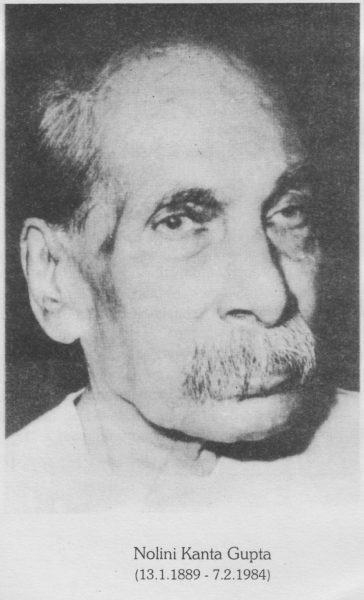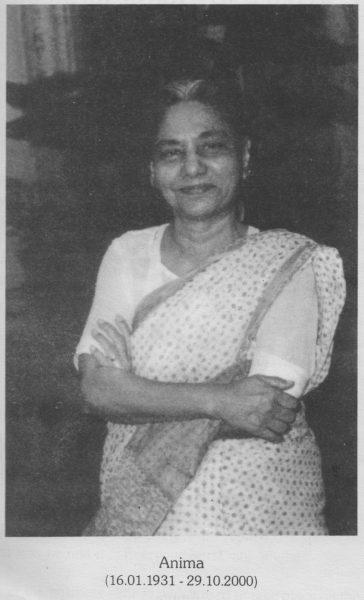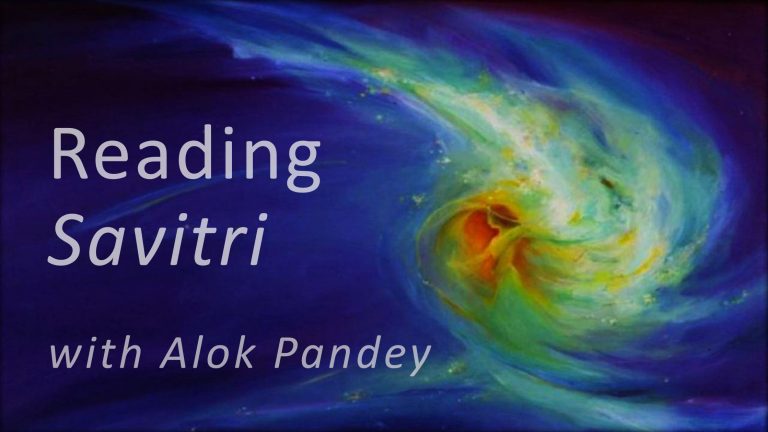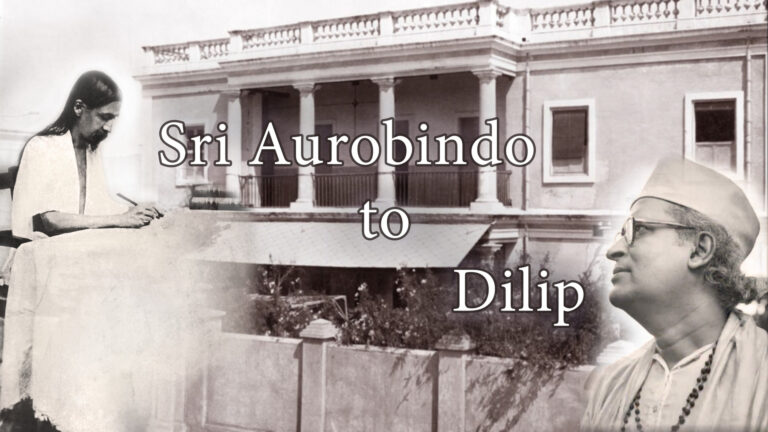
It was about ten years ago that we assembled in this historic playground of hallowed memories on the occasion of the Mother’s passing and it was Pranab who addressed you at that time. Most unexpectedly it is on the occasion of another departure that we have assembled again tonight. It is the passing of Nolini-da who was, to borrow a happy phrase, one of the first and foremost disciples of the Mother, her collaborator and our eldest brother. The sanctity, solemnity and beauty of this occasion my poor words cannot express though my mind can envisage it without fathoming it. His “unhorizoned” consciousness is too wide for human measurement and it never ceased to climb towards the heights even when he fell ill. At that time I was once called at night. He said, “You see, I went out of my body and when I came back, the body received a jerk. Hence this minor disturbance. You will understand. I don’t need any medicine.” The tone reminded me somewhat of Sri Aurobindo. I had come to know that often Nolini-da used to go out of his body and had to keep his hold on somebody’s hand in order to keep contact with the earth. I had read also the Mother saying that he could easily go out of his body to the Sachchidananda state. Well, these superconscious things are beyond me; I know a bit of the subconscious ones. Nevertheless I feel it my humble duty to present a few glimpses of his vast-visioned life to you so that you may have a rough idea of a person who rarely spoke of himself and to whom you may offer you gratitude and love for having quietly done so much for us. I must confess that most of what I shall say is based on my observation, reflection and conviction.
I had a moment’s sight of him when I met the Mother for the first time. She came to see me accompanied by Nolini-da, Amrita-da and Dilip-da. It was Dilip-da who had arranged the interview. Later, when I came to settle in the Ashram for good, I used to hear that Nolini-da was an enigma; he was a man of few words. People would not dare to assail his sanctum except on strict business. He was the secretary of the Ashram, but they all respected his aloofness. Often he used to be brusque with them and there were quite a number of anecdotes current in the Ashram about his abruptness. He had acquired the knack of upsetting people without himself getting upset. I shall quote two such stories. Once a sadhak complained to the Mother for what he considered Nolini-da’s rude behaviour to him. Sri Aurobindo wrote to Nolini-da about it. As a result he called the sadhak and apologised to him. On another occasion the hair-cutting saloon was to be opened. Nolini-da was approached; he flatly refused. The person wrote to the Mother and proposed another name instead. When, next day, Nolini-da went to see the Mother, she asked him why he had refused. On coming down, he hastened to the saloon and opened it. Therefore I used to avoid him. There you can see two traits in his nature, the outer somewhat jerky and the inner obedient to the Mother. Amrita who was his close associate used to say that Nolini-da was like yasti madhu. You have to chew it before you taste its sweetness. What a conversion took place in the later phase of his life! I marvelled at it. But let me not anticipate.
Though I kept myself at a distance, his learning and writings had a great attraction for me. I admired and respected him for them as well as for his personality. His passion for knowledge, which made buying books his one hobby, could be summarised by a verse from Savitri: “He sought for knowledge like a questing hound.” If the small can be compared with the great, I had also such a passion, but a minor one and I tried to satisfy it at Sri Aurobindo’s expense. You know the way I provoked, pestered, even bothered him with a host of questions. While I did this, Nolini-da gathered him in the vast cathedral of his mind and seated him on its high altar as the supreme deity. You know how Sri Aurobindo initiated him in the esoteric lores of the Vedas and Upanishads as well as in the secular knowledge of various literatures and languages. Sri Aurobindo’s heart must have been gladdened to find such a worthy young mind. Thus his approach to Sri Aurobindo was through the mind. I need not dwell at length upon this aspect, since his erudition is quite well known. Perhaps I can summarise it by quoting another expression from our Shastra. Both para vidya and apara vidya were at his command and they have all gone into 10 volumes of Bengali and 8 volumes of English works. They can make a side-stream running along with Sri Aurobindo’s vast Brahmaputra-like productions, fed and nourished by them and flowing into oneness with them. Sri Aurobindo has said that Nolini-da had a remarkable mind. But some people have found its works an echo, a shadow of Sri Aurobindo. Even if they were a shadow, they were a luminous shadow.
I have often wondered how he could contain such “infinite riches in a little room.” For except his broad and high forehead, the other parts of his body were frail. His forehead often made me think of Shakespeare and Einstein. In fact, often during our medical visits in the morning when he had just come down from the inner empyrean as if with the gold dust of trance-land still on his body, a few locks of hair disarrayed, eyes dreamy, he looked very much like a mystical Einstein. But after he had had his wash, combed his hair and brushed his pet moustache, he was the elegant incarnation of Virgil.
Still, he was by no means a book-worm, recluse. He had his hands full. He had to manage the bulk of the Mother’s and Sri Aurobindo’s correspondence, distribute their letters to sadhaks and carry on other work. His domestic chores he did himself: washing his own clothes, making his bed, bringing his kuja-water, preparing his own tea, polishing his shoes, etc. He had a weakness for shoes. When Sri Aurobindo wanted to get rid of a pair of Vidyasagari shoes, having no further need for them, he said they could be given to Nolini since he was fond of shoes. He was a bit of a dandy. He was doing regular athletic exercises and taking part in competitions. Mass drill was his favourite item and he participated in it till his late seventies.
Every fraction of his life was disciplined and methodised. That is the external reason of his keeping fit and being capable of a huge output in a single life. I wonder if mere is any world-figure today with so many facets combined and harmonised to such a degree of perfection. But where is the key to be found for such various accomplishments? It was certainly his inner development that was the secret of his outflowering. He practised yoga with one-pointed concentration and took up his literary and other activities as a part of it. As in Sri Aurobindo’s own case so in Nolini-da’s and in other cases of outer flowering in art, literature, etc. in the Ashram, yoga and the Mother’s and Sri Aurobindo’s force were mainly responsible for success. It seems that during the most brilliant period of the Ashram in 1927, when the Mother was bringing down the gods into the sadhaks, there came down into Nolini-da’s adhara the consciousness of Varuna, the Vedic god of Vastness. Hence the vastness in his writings. One could never achieve such an amplitude and integrality by mere mental labour. The work of the mere mind would be lop-sided. Nolini-da’s later productions, like those of his Master, must have been written from a silent mind. I would say transcribed rather than written. I would have doubted such a process, had not Sri Aurobindo convinced me by his thundering words and logical arguments during our correspondence.
Now I enter a terra incognita. To talk of the inner development of a Yogi is like a layman perorating on the theory of relativity. Fortunately I can draw upon some casual hints given by the Master and the Mother. Once when someone complained that Nolini-da was not doing Sri Aurobindo’s yoga since he kept aloof, was unsociable, etc., Sri Aurobindo replied, “If Nolini is not doing my yoga, who is doing it? Is sociableness a part of yoga?” Secondly, it was alleged that the sadhaks here would count for nothing in the world outside. Hearing which, Sri Aurobindo remarked, “The quality of sadhaks is so low?… There are at least half a dozen people here who live in the Brahmic consciousness…” This statement excited my curiosity and I surmised that Nolini-da must be one of these. I began to study his outer life. I could not get any clue. He was a closed shell, would not expose his pearls to an outsider. Besides, I was just a novice and had not the ghost of an idea of what the Brahmic consciousness was. Apropos of my query I received another sweetly castigating letter from the Master. None the wiser, I went on merrily without caring about Brahman, for Sri Aurobindo was my Brahman till he passed away. And then the Mother filled his place. In the sixties came a startling disclosure from the Mother. She wrote on Nolini-da’s birthday card — “Nolini en route towards the superman.” The years that followed brought a succession of revelations: “Nolini, with love and affection for a life of collaboration” …. “For the prolonged continuation of this happy collaboration” …. and lastly, in 1973, “With my love and blessings…. for the transformation. Let us march ahead towards the Realisation.” These are very big words indeed. I don’t know if any other person received such encomiums. I could now understand to some extent what these expressions meant and I was struck speechless. But Nolini-da swallowed all calmly and with ease. The coming superman did not undermine the natural man. I could not glean his ample inner field. Perhaps he was marching ahead with the Mother and when there was “one more step to take and all would be sky and God,” the greatest calamity befell the earth. The Mother passed away. There was an overclouding gloom, dejection, consternation.
It was then that Nolini-da came forward and took the lead as it were. When the Mother’s body was brought down and laid in the Meditation Hall, the Trustees came and Nolini-da was called from his room. He was requested to say a few words. Keeping quiet for a moment, he stood up straight like a column of light and said some words whose purport is: “Let us stand together and go forward in harmony and collaboration. The Mother has said she will be with us in our consciousness.” He felt perhaps that a vacuum had been made and he must do his part.
From that time a new life began for Nolini-da and a new phase for us. He had to come out of his shell. All eyes were turned to him for guidance, for help spiritual and mundane. He was invited to witness many functions; his approval was sought in many activities. In other words, he was called to shoulder a big part of the Mother’s spiritual work. A plethora of visitors asked for his touch. His writings were continuing in the same way and he used to read some of them in the School, in the Playground and in the Meditation Hall in front of his room. The idea, I believe, was to hold the Ashramites together and bathe them in the spiritual Presence. The Mother had assigned to him a French class for the elders and he continued it. In this manner, he was coming out more and more and his presence and nearness were available. It will not be an exaggeration to claim that he held the divisive tendencies together and saved us from falling apart. His hold particularly on the youth was of very good augury. When he had to undergo an operation for a cataract, the young boys kept vigil over him for about three months. Strange enough to observe that people operated upon along with him or afterwards got cured in two or three weeks while he took three months or so owing to a number of complications. He remarked jocularly that because he was given so much attention Nature took revenge.
In 1977, he had an apocalyptic vision of the Mother. He writes: “The Mother says, ‘Just see. Look at me. I am here come back in my new body — divine, transformed and glorious. And I am the same Mother, still human. Do not worry. Do not be concerned about your own self, your progress and realisation nor about others. I am here, look at me, gaze into me, enter into me wholly, merge into my being, lose yourself into my love, with your love; you will see all problems solved, everything done. Forget everything, forget the world. Remember me alone, be one with me, with my love.”
It was after this vision probably that he began to talk more and more about the Mother. To the departing students of the Higher Course he used to repeat that the Mother would be with them wherever they went. They were bound to her by a golden chain.
In 1978 either due to overstrain or some other reason he fell ill. Dr. Bose, Dr. Datta and myself formed a trio. I was the zero of the three, for my presence was more of a personal nature than a professional one. Now we enter the last phase of Nolini-da’s long career. It is a sweet song telling of sad things. His heart had gone wrong; to use Sri Aurobindo’s words, it was misbehaving. The blood pressure was high. The doctors succeeded in stabilising them. Satisfied with the progress Dr. Bose went to his home-town for about a month. After he had returned, there was a recrudescence of the symptoms and the condition took a serious turn. Consultation with an outside physician was thought of but Nolini-da had confidence in his doctors and vetoed the idea. However, things were becoming critical. Nolini-da himself said that he was passing away. The Calcutta people were informed. Somehow the faith and energetic intervention of the doctors, particularly of Datta, called down the Mother’s Grace and Nolini-da was sent back form the threshold. A slow recovery followed and along with it he took up gradually his previous work, but naturally modified according to his measure. His movements were now confined to the Ashram precincts. Apart from the recording of Savitri, translating it into Bengali, seeing visitors and various other minor activities, most of the time he used to keep to his bed. We were visiting him as usual. At this time or even before, I do not remember, my stock shot up with him, though I was only a pulse-taking doctor. He used to call me by name, “Nirod”, which had an Aurobindonian ring, and, stretching his hand, ask me to feel his pulse. Often he used to do that and ask: “All right?” When all of us had examined him, his query was again: “All right?” “Yes, all right, Nolini-da,” we would answer and depart.
No superfluous talk. Sometimes he would simply give a steady look and then utter, “Bonne nuit.” From Datta he would inquire about his patients or he would himself speak of some patients who had approached him. Monique, the French Ballet teacher, had a very bad fracture and had to be sent to France. Nolini-da used to inquire about her almost three times a day.
After that massive attack he never enjoyed sound health and was kept on drugs which he used to swallow without any murmur. Anima would exclaim that she had not seen any other person taking 4 or 5 bitter drugs a day as if it was a habit. When the symptoms increased, I being near at hand was called at night and, if necessary, the others were informed. At times all the three medicos were present. In addition to his own troubles, occasionally Nolini-da used to groan in sleep as if in pain over the ailments of his friends. Once he cried out repeatedly a person’s name. That person appeared to have been in a very critical condition that night and Nolini-da’s body received the vibration. There are numerous instances to show that he was sensitive to other peoples’ inner and outer condition and perhaps sent help to them in the yogic way. I know how in one case he cured an “incurable” malady or at least arrested it completely. He had given peace and taken away deep sorrow from people.
A woman had come from London and wanted to have Nolini-da’s darshan. She was asked to take my permission. I saw her coming back from the darshan with tears streaming from her eyes. I wanted to know the reason. She said that when she had got up after pranam, she was flooded with light coming down upon her. She was permitted to do pranam to him every day from a distance. This was the first concrete proof I had of his spiritual communicative power and my solar plexus was knocked out.
A few months before his passing, Dr. Bose suddenly passed away. Nolini-da was deeply moved. With tears in his eyes and a choked voice, he murmured: “What a fine soul! what a fine soul! He should not have gone before me.” Such human expression of feeling from him was something new to us. I believe that the loss made a dent in his heart. Once Bose had seen in a dream Nolini-da’s upper body full of golden light: the lower part had been absent. Nolini-da commented that, it was an overmind vision. A few days later, as he was lying in his bed, I asked him through Anima where his consciousness could be. He answered: “Why, with the Mother!” I wanted more precision. Then he answered: “In the Overmind.” I was simply swept off my feet. Though the Mother had indicated it, the information coming from Nolini-da himself had a tremendous effect upon me — I don’t know how people in general would understand the significance of that large utterance. Quietly I went away and tried to absorb the impact, for I knew by that time what it meant and at once in a flash many of his actions or decisions which had puzzled us were revealed in a new light. He was suspected to have some weakness for his family. He replied: “Great souls are beyond such ties.” For the first time in our knowledge he had made a personal reference. We were also baffled by his attitude towards those who were known to do harm to the Ashram. Then, when I saw him distributing his own photos to selected people, I was piqued. Now all these bizarre-looking movements troubled me no more and every question was set at rest. The mystery and mystique of all his actions became clear to me. Later I learned from Anima that Nolini-da had confided in her that he was mostly in the Overmind but at times a little beyond it.
To resume, yet cut our story short: Bose had gone from the doctor-group, two were now in harness, Datta’s being the main labour — I was an adjunct. Nolini-da was comparatively well and we expected that he would score his century. Anima and Matri Prasad, his two closest attendants, were regaling him with many stories and he too was indulgent to them. They were very free with him and would cut jokes again and again. I myself used to feel embarrassed at times; for this image of Nolini-da was a new development and I kept always my old attitude of respect towards him. In this period, which was a little before Bose’s departure, his most memorable action was to go and see Vasudha on her last birthday. We were somewhat alarmed. She had been bed-ridden. Nolini-da would often inquire about her and Datta kept him informed. I think Nolini-da had realised that Vasudha’s days were numbered. So he took this opportunity, though he could hardly walk even a few steps. We had great difficulty in putting him in a car and getting him just across the road. He sat before Vasudha with his chest heaving from exhaustion, took her hands into his own, blessed her and then came back.
His Bengali translation of Savitri had been completed and was expected to come out before his next birthday. Since the last months of 1983 things had begun to take a bad turn. His old pain in the heart re-appeared, stringent measures had to be taken regarding seeing visitors and other activities. His birthday on January 13 which had been expected to be a day of jubilation passed quietly, but he did not fail to meet the out-going students and give his blessings. Pain and distress were now on the increase. All modern measures were adopted, but only with momentary relief. Again the question of consulting a known heart-specialist was thought of, but met with disapproval. Distress and agony pervaded the general picture. We were at constant call and the attendants were ever vigilant, particularly at night. Less than a week before the last act, Nolini-da said to Anima that he would like to distribute his Savitri translation to all the attendants. Books were a bit late in coming. He ordered: “Get the books quickly and call the people.” This was the last gesture. As Savitri was Sri Aurobindo’ last composition, its translation has added a large dimension to the Bengali language. When more than once doubts were raised about the exactness of some words, Nolini-da said with force: “One has to read the Vedas, Upanishads, Mahabharata, Sanskrit literature before questioning their use.” He surprised me by this unusual self-estimation.
On the 7th February the closing scene was enacted. We had examined him in the morning. The condition, though bad, was not critical. At noon, I heard that he had taken his usual meal and relieved himself. Datta was by his side. I was suddenly called at 4 p.m. and informed that after the motion Nolini-da had collapsed. When I came down, Datta said with a gloomy air that there was a sudden fall of blood pressure. Nolini-da had gone within; his eyes were shut; the pulse was thready and he was sweating profusely. The end was near. I sat by his side and called “Nolini-da!” his opened his eyes, gave a look of recognition as if from the Beyond and closed his eyes. Slowly, quietly, the breathing stopped at 4.42 p.m. — the grand finale of the long epic story.
Once I had collapsed due to a sudden fall of blood-pressure. Nolini-da was informed that I was passing away. He came to see me and found that I had revived. He seems to have remarked later that I couldn’t go away, I had still a lot of work to do. I suppose, one of the assignments was to help in his departure.
The day after the event, his body was laid out in the Meditation Hall. Hundreds saw his chiselled face embalmed in a Nirvanic peace.
The rest of the story is well-known. One thing to be observed is that his body was taken to the Casanove garden in royal splendour. The procession of cars was something new in the history of Pondicherry. And almost the entire Ashram and group of visitors made their pilgrimage to the burial place as a token of their love and respect. That too was something unprecedented in our experience. A man who had lived a quiet, unassuming life and earned the veneration of thousands. The body was laid to rest by the side of his old friends and colleagues. Amrita-da and Pavitra-da, fulfilling his last wish.
Now when I ruminate over what I was given to observe of the last phase of Nolini-da’s life, a few rare qualities remain impressed upon my memory and reveal to me his true soul. First, his freedom from the taint of personality: ego was dead. He had love for all and sundry. Enemy he had none, not even those who were considered to be doing harm to the Ashram. He accepted them all as the Mother’s children and left it to her to judge them. In consequence he gained universal respect and confidence. The government also had trust in him and the Prime Minister stated that he radiated peace.
Secondly, he always preserved a strong strain of impersonality even with those people who were close to him. That was his natural genius. This was a typically Aurobindonian stamp. The other Aurobindonian stamps were: he would not push himself to the front and never interfered with what people did, even when they happened to be his near ones, unless approached for advice. He never criticised anyone and did not approve of anyone making criticisms and using strong language. A large liberality, sweetness and compassion crowned all his actions and movements. Even children used to love him. If he did not approve of anyone’s actions, he did not confuse the man with his actions. He could invite the man to sit by his side.
These were the later manifestations of his hidden nature. Once somebody complained to him about life and its difficulties. He answered: “Why am I here?” Then the person who had complained said: “You are needed for the Ashram. Therefore the Mother has kept you here.” In a grave tone Nolini-da declared: “I am here for a particular development. So far in my evolution there was the sattwic consciousness: the element of knowledge. Now a new element has been added: love, ananda. For that new growth I am here. But no use saying all this. People won’t understand and they will distort it.”
Some of his last utterances are worth recording. I was once called at night and found him sitting on the edge of his bed. He said: “You see, this body is of the earth earthy and will mix with the earth. But the realisation will remain.” Then in the last days he used to be in-drawn. We thought he was sleeping. When he came out of his absorption he had the appearance of an ever-joyous child and he also spoke and behaved like one. I said: “Perhaps you are in the Sachchidananda state” — to which he replied with a smile: “It is in an Anandamaya region.” On another occasion he was heard to mumble in an absorbed way: “Sat-yogi, Sat-yogi.” Asked whether he was by any chance referring to himself, he softly whispered: “Yes.” After that he withdrew almost wholly into himself, and when he spoke, it was to tell many that he would be leaving his body. On his 95th birthday he remarked. “This new year will be very critical for me.” When he was once asked where he would be after he had left his body he stated very clearly: “A little beyond the Overmind.” During those days he had also visions of three goddesses Chamunda, Kali and Gauri. About Chamunda, he said that she was trying to do mischief with his heart and he had detected it. Kali was all dark: everywhere there was darkness. In another vision he saw that he had gone away to a solitary place, all alone: there was no sign of life anywhere around. Then he saw Matri, following him.
When I try to assess his contribution to the sum-total of the Mother’s and Sri Aurobindo’s work, I feel that, short of the Supermind, he realised in himself a true synthesis of Sri Aurobindo’s Yoga and proved that this many-sided, complex, comprehensive Yoga is not an insane chimera. Further, he has made the path easier and smoother for posterity, as he has himself said that his realisation will remain. He serves as a bridge, an intermediary between us and the Mother. I can illustrate this point by citing the experience of a young sadhika the very night Nolini-da passed away. She went home with a heavy heart after seeing Nolini-da. She read a few pages from The Yoga of Sri Aurobindo before going to sleep. She dreamt that Nolini-da’s body had been shifted beside the Mother’s room on the second floor. People were going to see him in batches. When she arrived, she saw Nolini-da standing at the door radiant, youthful and full of zest. He called her in and cried loudly: “Come, come, today is my Bonne Fete.” Then he made her sit down and talked a lot on the Mother and Sri Aurobindo. Simultaneously she saw his dead body lying beside the wall, as it had been in his room. She was very much astonished. Then she read a chit from Counouma, asking her to go to Cazanove, since she was one of the attendants, and a vehicle had been arranged for the purpose.
Let us try, therefore, to be Nolini-like, to quote K.D. Sethna, if the Mother and the Master seem far beyond our reach.
Finally, my story will be incomplete if I fail to recognise the inestimable service rendered by our young people to whom we cannot be too grateful for what they have done night after night, specially Anima and Matri. Anima’s devotion and self-abnegation will be a matter of history. For years she looked after Nolini-da-his secretary, nurse, mother, sister all in one. As soon as he called “Anima”, she was there. She gave him all the royal comfort and ease he deserved. She may have her faults — who is free? — but, without her, Nolini-da would have left us long ago and in a very lamentable condition. Our admiration for her knew no bounds. She kept her eyes upon the comfort of the attendants as well. She was full of life and cheer and had a fund of tales, anecdotes, reminiscences by which she tried to enliven Nolini-da’s mood and mitigate his physical distress though she herself had high blood-pressure and was subject to headaches, pains and other ailments.
In conclusion let us hear a part of the recorded voice of Nolini-da where we get a clue to his true being. (svarupa):
“The story is after all the story of our adventure upon earth, a common adventure through centuries — not only through centuries but perhaps from the very creation of the earth. It is the story of the adventure of a group of souls, souls who were destined, who were created for the advent of a new creation. I will speak of only just a few bits and some important episodes of this adventure in which I participated, because you wanted to hear my life.
“We came, all of you, all of us who are here, most of them, in different epochs at the crucial stages of our evolution. In different periods, whenever there was a necessity of an upliftment or an enlightenment, we all came together, each in his own way. So one or two episodes like that I can tell. For example, in Europe a crucial turning-point of its history was the Renaissance, the new light. At the time of the Renaissance we all know that the creator of the Renaissance was Sri Aurobindo — Leonardo — and the whole Renaissance was his consciousness and all those who flocked around him, each one did his own work. You know that Amrita was intimately connected with that work — he was Michael Angelo. And Moni was also there — Suresh Chakravarty. He was one of the chief artists. I have forgotten his name…
“But all… the work they actually did, you know, the important thing, the consciousness they brought — expressed some sad event, some not so, but living concretising the consciousness…. My contribution in that age of Renaissance was in France. The Mother always said: ‘Your French incarnation was very prominent, even today it is very prominent.’ That little bit of evolution is still living. The consciousness at that time in France — that was also the beginning of the Renaissance and… the new creation, new poetry — I was a poet of that time and introduced the new poetry in France. At that time the king of France was Francois Ier. was in the political — also in the general life of the people he introduced this new light, new manner of consciousness. So I was with him. And who was Francois Premiere you know — Duraiswamy!
“The consciousness of the reality of that country was so strong that when I started reading or writing French — I wrote French — then sometimes I noted down some lines…. later I found that I had noted down exactly some verses of this poet of France, Ronsard…”
I may add an incident of recollection by Nolini-da of a past life. One day when he went to inspect our School garden, he was very much interested in observing the plan of the garden, the trees, the lotus pond and he remarked: “I was the gardener of Louis XIV, Le Nôtre.”
(Mother India, April 1984)




